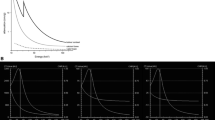Abstract
Dual energy CT leverages the acquisition of information obtained at high and low energies to provide enriched tissue characterization and material manipulation capability. Providing improved assessment of vascular stenosis, enhanced contrast visualization and reduction in artifacts associated with normal anatomy and implanted hardware, dual energy CT is increasingly popular in cross sectional and vascular imaging of neurologic disease.
Access this chapter
Tax calculation will be finalised at checkout
Purchases are for personal use only
Similar content being viewed by others
References
Pomerantz SR, Kamalian S, Zhang D, Gupta R, Rapalino O, Sahani DV, et al. Virtual monochromatic reconstruction of dual-energy unenhanced head CT at 65–75 keV maximizes image quality compared with conventional polychromatic CT. Radiology. 2013;266(1):318–25.
Watanabe Y, Uotani K, Nakazawa T, Higashi M, Yamada N, Hori Y, et al. Dual-energy direct bone removal CT angiography for evaluation of intracranial aneurysm or stenosis: comparison with conventional digital subtraction angiography. Eur Radiol. 2009;19(4):1019–24.
Uotani K, Watanabe Y, Higashi M, Nakazawa T, Kono AK, Hori Y, et al. Dual-energy CT head bone and hard plaque removal for quantification of calcified carotid stenosis: utility and comparison with digital subtraction angiography. Eur Radiol. 2009;19(8):2060–5.
Morhard D, Fink C, Graser A, Reiser MF, Becker C, Johnson TR. Cervical and cranial computed tomographic angiography with automated bone removal: dual energy computed tomography versus standard computed tomography. Invest Radiol. 2009;44(5):293–7.
Thomas C, Korn A, Krauss B, Ketelsen D, Tsiflikas I, Reimann A, et al. Automatic bone and plaque removal using dual energy CT for head and neck angiography: feasibility and initial performance evaluation. Eur J Radiol. 2010;76(1):61–7.
Ferda J, Novak M, Mirka H, Baxa J, Ferdova E, Bednarova A, et al. The assessment of intracranial bleeding with virtual unenhanced imaging by means of dual-energy CT angiography. Eur Radiol. 2009;19(10):2518–22.
Korn A, Bender B, Thomas C, Danz S, Fenchel M, Nagele T, et al. Dual energy CTA of the carotid bifurcation: advantage of plaque subtraction for assessment of grade of the stenosis and morphology. Eur J Radiol. 2011;80(2):e120–5.
Thomas C, Korn A, Ketelsen D, Danz S, Tsifikas I, Claussen CD, et al. Automatic lumen segmentation in calcified plaques: dual-energy CT versus standard reconstructions in comparison with digital subtraction angiography. AJR Am J Roentgenol. 2010;194(6):1590–5.
Go AS, Mozaffarian D, Roger VL, Benjamin EJ, Berry JD, Blaha MJ, et al. Heart disease and stroke statistics – 2014 update: a report from the American Heart Association. Circulation. 2014;129(3):e28–292.
Saba L, Argiolas GM, Siotto P, Piga M. Carotid artery plaque characterization using CT multienergy imaging. AJNR Am J Neuroradiol. 2013;34(4):855–9.
Zhang LJ, Wu SY, Poon CS, Zhao YE, Chai X, Zhou CS, et al. Automatic bone removal dual-energy CT angiography for the evaluation of intracranial aneurysms. J Comput Assist Tomogr. 2010;34(6):816–24.
Shinohara Y, Sakamoto M, Iwata N, Kishimoto J, Kuya K, Fujii S, et al. Usefulness of monochromatic imaging with metal artifact reduction software for computed tomography angiography after intracranial aneurysm coil embolization. Acta Radiol. 2014;55(8):1015–23.
Carrascosa P, Capunay C, Rodriguez-Granillo GA, Deviggiano A, Vallejos J, Leipsic JA. Substantial iodine volume load reduction in CT angiography with dual-energy imaging: insights from a pilot randomized study. Int J Cardiovasc Imaging. 2014;30(8):1613–20.
Delesalle MA, Pontana F, Duhamel A, Faivre JB, Flohr T, Tacelli N, et al. Spectral optimization of chest CT angiography with reduced iodine load: experience in 80 patients evaluated with dual-source, dual-energy CT. Radiology. 2013;267(1):256–66.
Author information
Authors and Affiliations
Corresponding author
Editor information
Editors and Affiliations
Rights and permissions
Copyright information
© 2015 Springer International Publishing Switzerland
About this chapter
Cite this chapter
De Leacy, R., Tanenbaum, L. (2015). Dual Energy-Spectral CT in Neurovascular Imaging. In: Carrascosa, P., Cury, R., García, M., Leipsic, J. (eds) Dual-Energy CT in Cardiovascular Imaging. Springer, Cham. https://doi.org/10.1007/978-3-319-21227-2_6
Download citation
DOI: https://doi.org/10.1007/978-3-319-21227-2_6
Publisher Name: Springer, Cham
Print ISBN: 978-3-319-21226-5
Online ISBN: 978-3-319-21227-2
eBook Packages: MedicineMedicine (R0)




